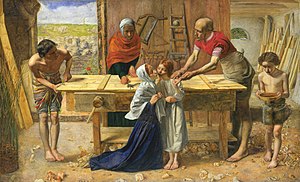Christ in the House of His Parents
| Christ in the House of His Parents | |
|---|---|
 |
|
| Artist | John Everett Millais |
| Year | 1849–50 |
| Medium | Oil on canvas |
| Dimensions | 86.4 cm × 139.7 cm (34.0 in × 55.0 in) |
| Location | Tate Britain, London |
 |
|
|
|
Christ in the House of His Parents (1849–50) is a painting by John Everett Millais depicting the Holy Family in Saint Joseph's carpentry workshop. The painting was extremely controversial when first exhibited, prompting many negative reviews, most notably one written by Charles Dickens. It catapulted the previously obscure Pre-Raphaelite Brotherhood to notoriety and was a major contributor to the debate about Realism in the arts.
It is currently housed in the Tate Britain in London.
The painting depicts the young Jesus assisting Joseph in his workshop. Joseph is making a door, which is laid upon his carpentry work-table. Jesus has cut his hand on an exposed nail, symbolizing the stigmata and foreshadowing Jesus' crucifixion. As his grandmother, Anne, removes the nail with a pair of pincers, his concerned mother, Mary, offers her cheek for a kiss and Joseph examines his wounded hand. A young boy, who would later be known as John the Baptist, brings in water to wash the wound, prefiguring his later baptism of Christ. An assistant of Joseph's, who represents Jesus' future Apostles and chroniclers observes these events.
In the background of the painting various objects are used to further symbolize the theological significance of the subject. A ladder, referring to Jacob's Ladder, leans against the back wall, and a dove which represents the Holy Spirit rests on it. Other carpentry implements refer to the Holy Trinity. Millais likely used Albrecht Dürer's print Melancholia I as a source for this imagery, along with quattrocento works. The sheep in the sheepfold seen through the door represent the future Christian flock.
...
Wikipedia
